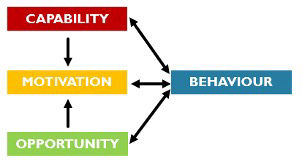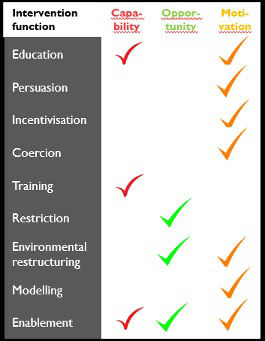3 frameworks and models to help drive behaviour change – part 3
a 3-part series which will explore key applications of three well-known behaviour change frameworks and models.

Article series
3 frameworks and models to help drive behaviour change
- 3 frameworks and models to help drive behaviour change – part 1
- 3 frameworks and models to help drive behaviour change – part 2
- 3 frameworks and models to help drive behaviour change – part 3
This three-part series began by illustrating why changing others’ behaviour can often be difficult. It went on to describe how behaviour change frameworks such as EAST and MINDSPACE can help increase the chances of success. However, three key criticisms of the frameworks were also presented.
First, they were criticised for not being based on any specific theory. Second, it was suggested they may be too narrow in scope and over-reliant on behavioural economics insights. Finally, their ability to help tackle complex, longstanding behavioural challenges was questioned. This final article demonstrates how more rigorous behaviour change models can increase the chances of success – particularly when used alongside (primary and/or other) research.
Behaviour change models
As previously discussed, frameworks provide an overall picture of possible courses of action that may be taken to help bring about behaviour change. Behaviour change models do the same, but they also provide greater depth by representing or explaining the operation or mechanism of something. This allows us to develop hypotheses about why people are behaving as they are currently. It also helps us to minimise any incorrect assumptions we may make about behaviour and to avoid potentially important omissions.
COM-B model
One proven behaviour change model (summarised below) is the University College London developed COM-B. This synthesises findings from nineteen behaviour change frameworks. In summary, to do a behaviour, someone must have three things: the Capability, Opportunity, and Motivation.

First, Capability describes the need for the person or people concerned to have the physical strength, knowledge, skills, or stamina to perform a behaviour. Opportunity describes the need for a conducive physical and / or social environment. Finally, motivation describes how the person or people must have sufficiently strong motivation at the relevant time. These three pillars help us generate hypotheses as to why a behaviour is – or is not – occurring.
Behaviour Change Wheel (BCW)
However, using COM-B also helps us to understand possible courses of action which could be taken to generate behaviour change. COM-B sits within the Behaviour Change Wheel (BCW) which contains nine ‘intervention functions’. These are broad categories of things one can do to change behaviour. The table below shows how each intervention function is mapped to one or more of the three pillars of COM-B discussed above.

For example, based on the above, if Capability is hypothesised or found to be a barrier to behaviour change in a particular scenario, the BCW suggests this could be addressed through one or more of the following intervention functions: Education, Training, Enablement (see red ticks above).
Finally, the BCW contains one further important mapping: the nine intervention functions (above) to 93 ‘behaviour change techniques’ (BCTs). BCTs represent potential, more specific, proven actions which could be taken.
To illustrate COM-B and the BCW in action, below is a summary of a real-life market research study we undertook recently.
Example: Using COM-B and the Behaviour Change Wheel (BCW)
Our pharmaceutical client had recently launched a new product and wanted to better understand likely uptake levels among physicians. They also wanted to understand what they could do to increase future uptake.
First, we used the three pillars of COM-B, alongside prior research, to categorise physician key needs. For example, under the Capability pillar, a key physician need was knowledge about new products.
Second, quantitative primary research was used to test physician perceptions of the client’s product against each key need identified. The biggest deficits were Capability related: many said their knowledge about the product was low.
Finally, the BCW was used to help suggest interventions to address the gaps in knowledge (Capability) identified. Based on the table above, the ‘Education’ intervention function was proposed to be important. Further, more specific BCTs sitting under ‘Education’ were also suggested, e.g. presenting information about the positive consequences (not just the features) of the client’s product.
This type of approach can be used in any sector. Further, while the example above drew heavily on primary research, insights may instead come from less expensive approaches such as stakeholder feedback or desk research.
Conclusion
This article has demonstrated how behaviour change models (and COM-B / the BCW in particular) can increase the chances of behaviour change success. These are especially powerful when used alongside (primary and / or other) research.
However, a final caveat: it is vital to apply the most appropriate model to the situation in question – otherwise there is a risk of key factors being overlooked. While this series has presented three well-known frameworks and models, there are a great many other, often more specific potential options which may be more suitable depending on the business question. Among other things, the most suitable model (or framework) will be informed by the nature and complexity of the challenge, along with the resources available.
This article series contains selected highlights from “Four frameworks and models to help drive behaviour change” – a new, introductory guide written by Activate Research which will be released on 7th February 2023. To pre-order a free copy go to https://www.activate-research.com/behavioural-models-guide
Chris Harvey
Founder at Activate ResearchChris Harvey is the Founder of Activate Research. He is an expert in helping research agencies add complementary insights from behavioural science (and psychology more broadly) to their research offer, enabling end clients to better understand, predict and influence target audience behaviour. Chris has over 10 years’ experience in the research industry, working for agencies including Dunnhumby, GfK and YouGov, and in 2016 achieved a Distinction in MSc Behavioural Science.
Article series
3 frameworks and models to help drive behaviour change
- 3 frameworks and models to help drive behaviour change – part 1
- 3 frameworks and models to help drive behaviour change – part 2
- 3 frameworks and models to help drive behaviour change – part 3


